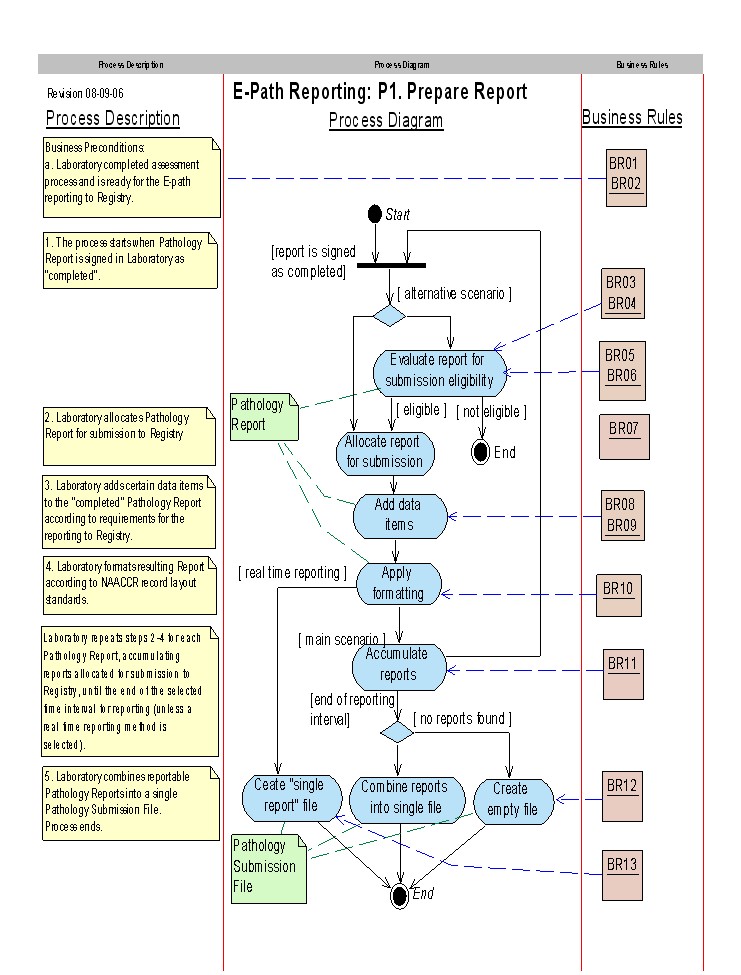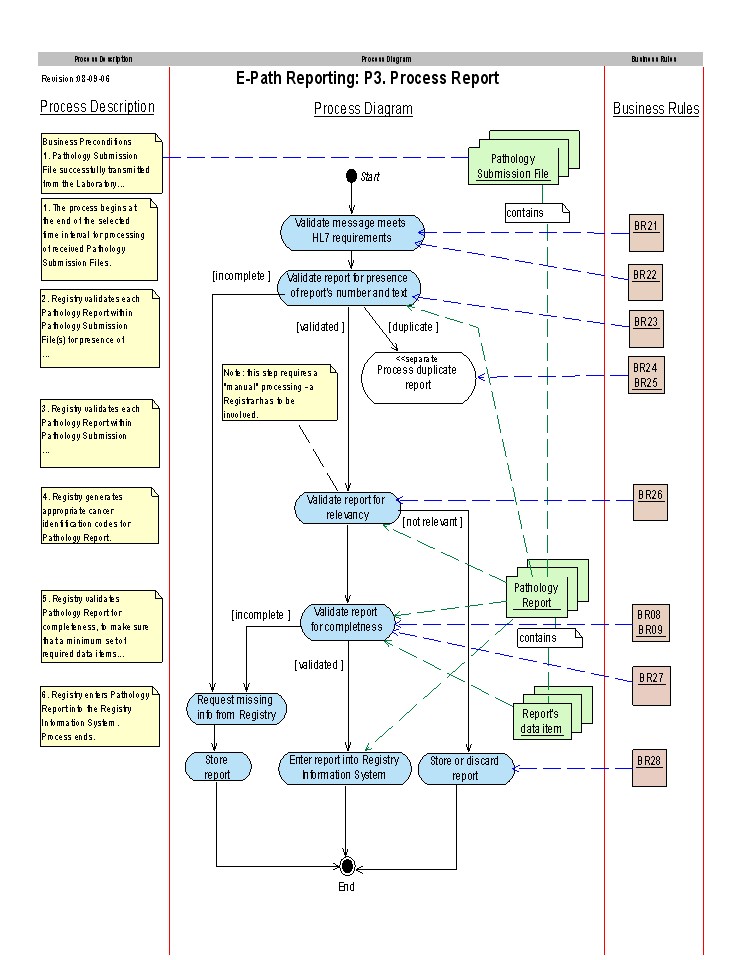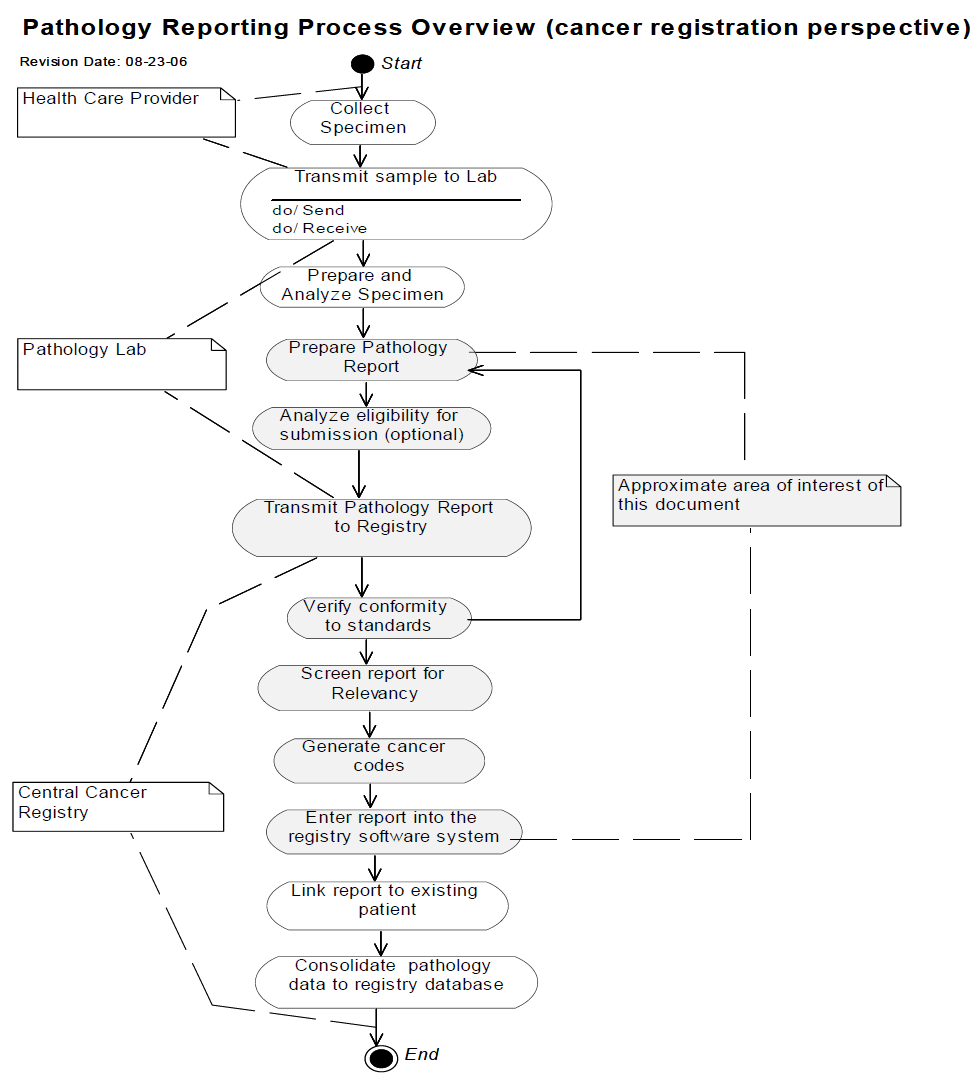Difference between revisions of "Cancer Registry Pathology Report"
| Line 124: | Line 124: | ||
Content modules describe the content of a payload found in an IHE transaction. Content profiles are transaction neutral. They do not have dependencies upon the transaction that they appear in. | Content modules describe the content of a payload found in an IHE transaction. Content profiles are transaction neutral. They do not have dependencies upon the transaction that they appear in. | ||
| − | {{Fixme| | + | {{Fixme| Keith to modify}} |
==== Content Module 1 | ==== Content Module 1 | ||
| − | {{Fixme| | + | {{Fixme|Keith to modify}} |
=== Process Flow === | === Process Flow === | ||
Revision as of 13:37, 22 May 2008
Introduction
This is a draft of the Cancer Registry Content Profile (CRC) supplement to the PCC Technical Framework. This draft is a work in progress, not the official supplement or profile.
Profile Abstract
The Cancer Registry Content Profile (CRC) defines the the content used in the PCC-11 to send a completed pathology report to a Cancer Registry using an HL7 Version 2.3.1 ORU message.
Glossary
Refer to the Glossary posted on CDC's National Program of Cancer Registries Modeling Electronic Reporting Project website: www.cdc.gov/cancer/npcr/informatics/merp/TBD
Issue Log
Open Issues
- Issue: Dependencies: need help understanding this component
- Depends on Care Management with the V2 option (and by reference ATNA and CT)
- Issue: Modify Actor/Transactions (Keith)
- Issue: Modify Content Module for V2 profiles (Keith)
- Issue: Grouping: Does this need to be modified for the CRC profile?
- Yes, not sure how
- What should go under Header Template 1?
- What should go under Entry Template 1?
![]() -->>Register Pathology Implementation Guide with HL7 Message Profile Registry<<--
-->>Register Pathology Implementation Guide with HL7 Message Profile Registry<<--
- In Progress
Closed Issues
- Issue: Glossary: Use MERP glossary document or consolidated glossary tool?
- Refer to the existing document
- Issue: Options: need help understanding this component
- Won't have any
- Added options based on discussion at May f2f meeting.
- Issue: Transaction Definitions: need help understanding this component
- Not relevant to this profile
- Issue: What information do we need to include in 3.1.2, 3.1.3, 3.2, 3.3, 3.4?
- Just reference the NAACCR Documentation on this section
- Should we include a sample message?
- include a link to a webpage of a sample message. There are ways to convert a document to a webpage....
Volume I
Add the following bullet to the list of profiles
- The Cancer Registry Content Profile (CRC) defines the the content used in the PCC-11 to send a completed pathology report to a Cancer Registry using an HL7 Version 2.3.1 ORU message.
Dependencies
Add the following row(s) to the list of dependencies
| Integration Profile | Dependency | Dependency Type | Purpose |
|---|---|---|---|
| Cancer Registry Content | Care Management
ATNA CT |
Cancer Registry Content
The Cancer Registry Content Profile (CRC) defines the the content used in the PCC-11 to send a completed pathology report to a Cancer Registry using an HL7 Version 2.3.1 ORU message.
Monitoring the occurence of cancer is a cornerstone of cancer control decision making. this monitoring, referred to as cancer surveillance, can be used to trigger case investigations, follow trends, evaluate the effectiveness of prevention measures such as screening and early detection programs and suggest public health priorities. It is vital to identify and registrar all cancer cases. By not identifying all of the cancer cases, cancer incidence will be underestimated, giving a false impression of the magnitude of the cancer problem in the registry’s population area. Inaccurate incidence rates can misdirect cancer control efforts, and provide a false picture of the effectiveness of treatment efforts.
Because most cancers are definitively diagnosed by microscopic examination of tissue, cancer surveillance programs rely on pathology reports to identify new cases and collect further information on cases previously reported.
Two challenges relate to pathology laboratory reporting of cancer cases. Laboratories may photocopy selected pathology reports and mail them to the cancer registry. This method is labor intensive and prone to missing cases because the laboratory staff is not aware of the full case definition for identifying a cancer case. Additionally, the cancer registry staff must re-enter the information into the cancer registry with a risk of data entry errors.
Alternately, laboratories may choose not to actively report cases, but allow cancer registry personnel to identify and photocopy appropriate pathology reports on site. This is very costly for the registry and has the same risk of data entry errors when the reports are manually entered into the registry database.
Use Cases
- Pre-condition
A woman goes in for a routine mammogram and a suspicious area is noted. The woman is referred by her family physician to a surgeon who does a biopsy and sends the tissue sample to the pathology laboratory for review and diagnosis.
The pathology laboratory receives the specimen, logs it into the laboratory information system (LIS) and prepares the specimen for analysis. The pathologist analyzes the specimen and dictates his/her findings, which are then transcribed into the LIS. The pathologist verifies the accuracy of the report and signs the transcribed report. The LIS marks the pathology report as "Final", triggering the use case events.
- Events
- 1. Pathology Laboratory Creates Message
The LIS identifies that the report matches submission criteria because it is a histopathology test (biopsy) and the diagnosis relates to cancer ("carcinoma"). The LIS gathers information from its database and other appropriate databases to create a message that contains all of the required data elements. The LIS validates the data to ensure it conforms to the HL7 2.3.1 ORU-RO1 specification and transmits it to the Cancer Registry using a secure connection.
- 1. Cancer Registry Processes Registration
The Cancer Registry receives the HL7 messages, parses it into the processing database and determines that a cancer diagnosis has been documented. The Cancer Registry staff codes the medical information. The pathology data and coded information is exported to the Cancer Registry Database and the message is archived.
- Post-condition
Pathology information has been added to the Cancer Registry Database.
The message is available for future use as needed.
Scope
The following diagram constrains the scope of the Content Profile.
Actors/Transaction
There are two actors in this profile, the Content Creator and the Content Consumer. Content is created by a Content Creator and is to be consumed by a Content Consumer. The sharing or transmission of content from one actor to the other is addressed by the appropriate use of IHE profiles described below, and is out of scope of this profile.
![]() -->>Update the following to deal with CM and RFD<<--
A Document Source or a Portable Media Creator may embody the Content Creator Actor. A Document Consumer, a Document Recipient or a Portable Media Importer may embody the Content Consumer Actor.
-->>Update the following to deal with CM and RFD<<--
A Document Source or a Portable Media Creator may embody the Content Creator Actor. A Document Consumer, a Document Recipient or a Portable Media Importer may embody the Content Consumer Actor.
The sharing or transmission of content or updates from one actor to the other is addressed by the use of appropriate IHE profiles described by section 3.7 Content Bindings with XDS, XDM and XDR found in the Patient Care Coordination Technical Framework
Options
Grouping
Basic Patient Privacy Consents (BCCP)
When patient consent is required, the Content Creator of the Cancer Registry Content profile may be grouped with the Content Consumer Actor of the BPPC profile. When grouped with that actor, the Content Creator shall verify that an appropriate consent has been registered for the patient to share the pathology data prior to sending the message.
Patient Demographic Query
Patient Identity Cross Referencing
Content Modules
Content modules describe the content of a payload found in an IHE transaction. Content profiles are transaction neutral. They do not have dependencies upon the transaction that they appear in.
==== Content Module 1
Process Flow
- Not relevant for this Content Profile
Actor Definitions
- Actor
The Content Creator is played by the Laboratory Information System.
The Content Consumer is played by the Cancer Registry Software System.
Policy Considerations
- Batch or Real Time Reporting
Because the Cancer Registry Content Profile relates to secondary use of data, Batch Reporting with a frequency of every 24 hours is recommended.
- Case Selection
A Content Consumer may require that all reports be transmitted, regardless of relevance to cancer, or it may require transmission to be restricted based on specific selection criteria. This is a policy decision for the Content Creator based on laws, regulations, rules and operating policy.
Security Considerations?
Transaction Definitions
- Transaction
- Not relevant for the Cancer Registry Content Profile
Volume II
![]() -->>Give an example of how the notification and query messages need to look to implement this content profile<<--
-->>Give an example of how the notification and query messages need to look to implement this content profile<<--
Cancer Registry Content
Consists of the anatomic pathology reports:
- histopathology
- flow cytometry
- cytology
- autopsy
- bone marrow
- peripheral smear
Standards
- Content
- [1] : North American Association of Central Cancer Registries Standards for Cancer Registries Volume V: Pathology Laboratory Electronic Reporting; Version 2.1
- Message Specification
- HL7 2.3.1 ORU - Unsolicited Observation Message (event RO1)
- Standards for Identifying Pathology Reports
- [2] : NAACCR Search Term List
- Case Definition
- [3] : Chapter III. Standards for Tumor Inclusion and Reportability. NAACCR Standards for Cancer Registries Volume II: Data Standards and Data Dictionary. Twelfth Edition; Record Layout Version 11.2.
- Coding of Medical Information;
- World Health Organization : International Classification of Diseases for Oncology (ICD-0) Third Edition
Data Element Index
- [4] : Refer to NAACCR Standards for Cancer Registries Volume V: Pathology Laboratory Electronic Reporting Verison 2.1, Chapter 2.6
Document Specification
Not relevant for this Content Profile.
Section Template 1
Refer to NAACCR Standards for Cancer Registries Volume V: Pathology Laboratory Electronic Reporting Verison 2.1, Chapter 2.6
Header Template 1
<entry>An XML Example</entry>
entry
Refer to NAACCR Standards for Cancer Registries Volume V: Pathology Laboratory Electronic Reporting Verison 2.1, Chapter 2.6
Entry Template 1
<entry>An XML Example</entry>



